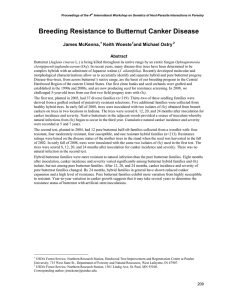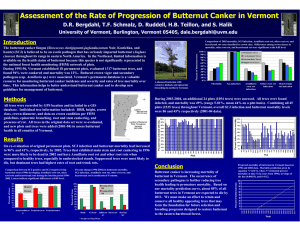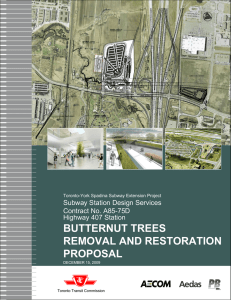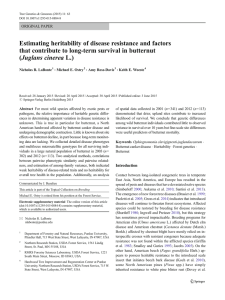ASSESSMENT OF BUTTERNUT HEALTH ON PUBLIC AND PRIVATE LANDS IN...
advertisement
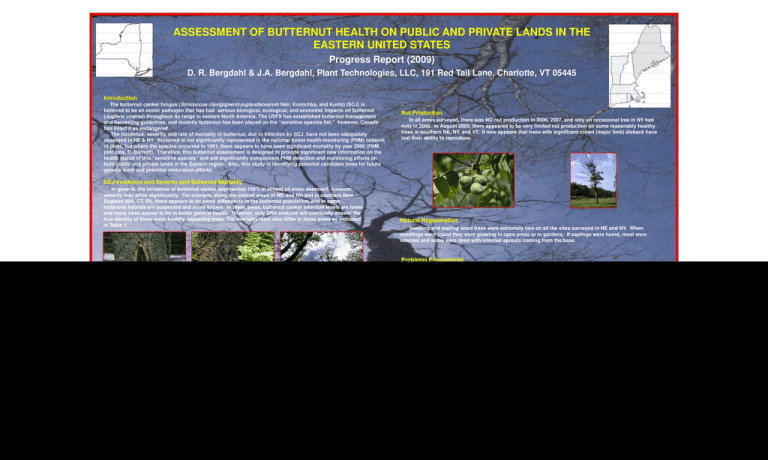
ASSESSMENT OF BUTTERNUT HEALTH ON PUBLIC AND PRIVATE LANDS IN THE EASTERN UNITED STATES Progress Report (2009) D. R. Bergdahl & J.A. Bergdahl, Plant Technologies, LLC, 191 Red Tail Lane, Charlotte, VT 05445 Introduction The butternut canker fungus (Sirococcus clavigignenti-juglandacearum Nair, Kostichka, and Kuntz) (SCJ) is believed to be an exotic pathogen that has had serious biological, ecological, and economic impacts on butternut (Juglans cinerea) throughout its range in eastern North America. The USFS has established butternut management and harvesting guidelines, and recently butternut has been placed on the “sensitive species list;” however, Canada has listed it as endangered. The incidence, severity, and rate of mortality of butternut, due to infection by SCJ, have not been adequately assessed in NE & NY. Butternut is not significantly represented in the national forest health-monitoring (FHM) network of plots, but where the species occurred in 1991, there appears to have been significant mortality by year 2000 (FHM plot data, C. Barnett). Therefore, this butternut assessment is designed to provide significant new information on the health status of this “sensitive species” and will significantly complement FHM detection and monitoring efforts on both public and private lands in the Eastern region. Also, this study is identifying potential candidate trees for future genetic work and potential restoration efforts. Nut Production In all areas surveyed, there was NO nut production in 2006, 2007, and only an occasional tree in NY had nuts in 2008. In August 2009, there appeared to be very limited nut production on some reasonably healthy trees in southern NE, NY, and VT. It now appears that trees with significant crown (major limb) dieback have lost their ability to reproduce. SCJ Incidence and Severity and Butternut Mortality In general, the incidence of butternut canker approaches 100% in almost all areas assessed, however, severity may differ significantly. For example, along the coastal areas of ME and NH and in southern New England (MA, CT, RI), there appears to be some differences in the butternut population, and in some instances hybrids are suspected and some known. In these areas, butternut canker infection levels are lower and many trees appear to be in better general health. However, only DNA analysis will eventually answer the true identity of these more healthy appearing trees. The mortality rates also differ in these areas as indicated in Table 1. Natural Regeneration Seedling and sapling sized trees were extremely rare on all the sites surveyed in NE and NY. When seedlings were found they were growing in open areas or in gardens. If saplings were found, most were infected and some were dead with infected sprouts coming from the base. Problems Encountered The main problem encountered was finding suitable butternut sites to assess. Our state cooperators have been helpful, but we needed more information about potential locations. Therefore, we obtained additional site location information from a variety of land management personnel (consulting foresters, arborists, USFS ecologists & wildlife biologists, Northern Nut Growers Association members, Native American groups, USDA Soil Conservation Service personnel, state park personnel, TNC, eco–reserves, community historians, and private landowners, etc.). These contacts took time but have been a good option for finding additional butternut sites. In addition, the variation in butternut and the so called “hybrid issue” in southern and eastern NE suggests these trees may have a different genetic make-up and, therefore, should be evaluated separately as a subset. Also, this project was without a Forest Service cooperator at the beginning and thus required more of my time for office activities which resulted in some field work delays. In addition, many additional butternut sites have been identified but funding resources are not available for their assessment at this time Other Disease Causing Agents There are a number of other disease causing agents that are also affecting the overall health of butternut. Root rots caused by Armillaria spp. and other fungi, may hasten the death of trees infected with SCJ. Trees that had severe root flare infections by SCJ usually showed evidence of extensive root rot. Also, heart and canker rot organisms were recorded along with other unknown cankering agents. These “other agents” of disease need to be identified and their overall importance in the decline and mortality of butternut assessed. Identification of Candidate Trees Reasonably healthy candidate trees, for future genetic work, have been identified at many sites. These trees appear to be butternut or at the very least butternut like. They are all located in areas where butternut canker was present and have been exposed to intense inoculum pressure but appear to have stood the test of time. I consider these trees to be good candidates but they need DNA assessment to determine their genetic purity. All candidate trees have health data recorded along with their GPS location. Table 1. A preliminary overview of butternut tree mortality by state and a listing of relatively healthy appearing “candidate” trees potentially resistant to SCJ. State ME NH VT*** NY MA* CT* RI* Totals # Trees 308+ 271 289 813 167 70 17 1935 # Dead 90 74 86 200 28 4 1 483 * Trees in southern NE may not be pure buternut ** Candidate trees showing resistance to SCJ *** Trees from the GMNF only (See previous study for additional details) % Dead # Candidate trees**_____ 28% 25** 27% 41** 30% 33** 25% 57** 16% 28** 6% (not included) 0 6% (not included) ____________________ 0__ 25% 184** Funding provided by: USDA FS FHM D.R. Bergdahl, cost share
